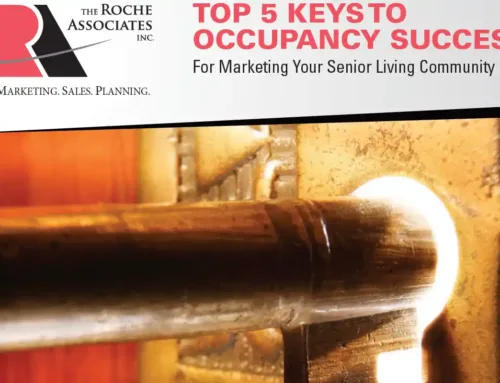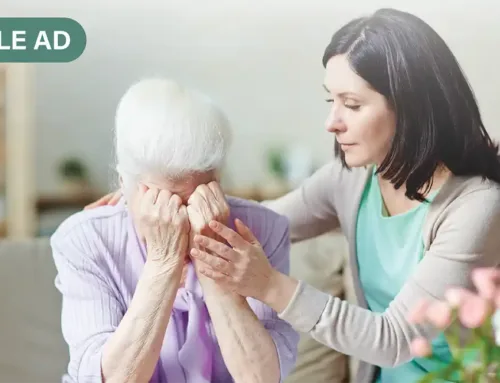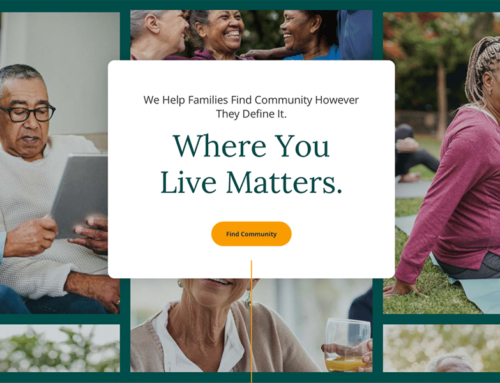by Ben Swett | Jun 12, 2020 | Opinion
The COVID-19 pandemic has likely changed the way seniors housing operators do business for some time to come, So, how do social distancing measures and a new threat to resident safety impact the sale and marketing strategies of these communities? We asked Joe Roche of The Roche Associates for answers.
We’re more than a couple of months into the COVID-19 crisis, and the seniors housing industry has experienced a bit of a PR problem. Given the virus’ effect on the frail and elderly, the media’s coverage of outbreaks at communities (mostly unfair, but also sometimes fair), and some people’s comingling of skilled nursing facilities with seniors housing, what would you say to a potential resident to address these issues and highlight the potential benefits of living in a seniors housing community today?
As you are aware, there is quite a bit of comingling of skilled nursing facilities with senior housing. In fact, the American Seniors Housing Association (ASHA) and Argentum are having a very difficult time getting funds earmarked for the senior living industry. Of the $100 billion that Congress apparently has appropriated for healthcare providers, ASHA, along with Argentum, has requested a $20 billion allocation from the HHS “Provider Fund” to help senior living communities endure the substantial financial strain COVID-19 is placing on the industry. Approximately $5 billion has been allocated to nursing homes already, but nothing has been allocated for other senior housing communities so far.
In response to the messaging to prospects, we recommend that senior housing communities address COVID-19 safety protocols head on. In truth, senior living communities are doing a far better job than most industries of enforcing protocols to keep people safe! From quarantining new residents for two weeks, to following strict safety and social distancing protocols, to restricting outside visitors until it is safe again, senior living communities in many cases are providing a safer environment than most people’s homes. In one’s own home, family members, home care workers, and other service providers who may have had exposure to COVID-19 can come and go, without necessarily following the type of strict safety protocols followed by senior housing communities. By living at a senior housing community, seniors can have their needs met, from meals to medication management, to on-site security, to transportation to doctors’ appointments, without having to worry about the stresses of leaving home and grocery shopping during a pandemic.
Residents of senior housing communities are still able to enjoy social engagement via creative activities that follow social distancing guidelines, so there is not the intense loneliness of being isolated at home, which can have significant psychological and physiological consequences. We also recommend that our clients connect prospects to current residents of their communities, particularly those who have moved during the crisis, who can talk about the higher quality of life in a community where meals, health care needs and socialization are all readily available, vs. being isolated alone at home during a pandemic.
How can your marketing and sales teams best get that message across to people? Phone? Online? Mail?
In our 39 years of experience in helping our clients achieve occupancy goals, we believe the best approach, during the pandemic and beyond, is a multi- channel marketing approach, including digital marketing and social media; direct mail; phone calls; marketing events, which for the moment are virtual, online events; and limited traditional advertising in markets where data supports its use. Based upon the overall positive results our clients have had with multi-channel marketing, we have discovered that digital marketing alone is not a panacea. You have to use the other channels to be able to effectively get your message across to prospects.
Overall, both from looking at current industry data and our experience, digital marketing tends to account for 12% – 15% of move-ins, which can be sourced to inquiries from company websites and the internet. Senior housing communities have to be cognizant of where the other 85% – 88% of sales are coming from.
Multi-channel marketing, including generating referrals from satisfied residents/family members, and professional referral sources is critically important. There’s no substitute for tried-and-true traditional activities, including marketing events, which for now are held online; direct mail; personal connection with prospects by phone, which can also be done via video chat platforms such as Zoom or FaceTime.
How can communities best replace or replicate marketing events or community tours?
For now, under current COVID-19 protocols, online virtual tours, information sessions, and events can replace “traditional” on-site marketing events. We recommend a Three Phase Plan during the COVID-19 era. We are now in Phase I in most cases, which is planning as many virtual events, information sessions, and webinars as possible. Posting regularly on social media about your communities’ strict adherence to safety protocols, and the positive life experiences your residents are having daily, is also important.
Phase II will be when there may still be restrictions or reticence to having prospects visit the given community, but more off-site public spaces are open. We recommend hosting off-site marketing events at public community spaces, like restaurants, banquet facilities, country clubs or hotels (following appropriate guidelines), or using green space to host outdoor programs.
Plan ahead now for Phase III, which will be when marketing events can be hosted on-site at your community(ies) again, but likely still with strict safety and infection prevention protocols in place for a while. It’s our opinion that the “new normal” in the future may be lower attendance at onsite marketing events than your community may have enjoyed previously, since some seniors may still be nervous about venturing out. However, there are creative ways to approach this and still reach more people – for example, simulcasting a live feed from an onsite marketing event on Facebook or another platform, so people can also watch and enjoy from the comfort of home.
What are the drawbacks to virtual tours that a salesperson can help mitigate?
Drawbacks can include some limitations in terms of the technical capabilities and comfort levels that prospects may have with technology. It’s helpful to have someone on the marketing team who can be available to offer “tech support” to prospects who may struggle to join a Zoom or other online meeting or call. Training can also be offered to staff, residents, and referral sources on Zoom or other platforms.
The bigger issue is that it can be more challenging to build and develop relationships and trust through technology, vs. in-person tours. These aren’t real estate sales, but sales that require building trust and emotional connection. Families need to feel that their loved one will be safe and happy at your community. To that end, in order to better connect with prospects, it is best if virtual tours are conducted live, rather than relying on pre-produced “virtual tour” videos. Using a tablet or a smart phone and a platform like Zoom or Facetime, sales staff can engage with the prospect live, and focus specifically on areas of the community they want to see. Where prospects are comfortable with a home visit, staff can also visit prospects in their home and provide a virtual tour via a pre-produced video, while having an opportunity to connect and engage.
One creative solution we have suggested to some of our clients that has worked extremely well is having them designate a first-floor apartment in their community that has patio access to the outdoors as a “model apartment.” Visiting prospects can enter through the apartment door for a tour, and do not enter the rest of the community, so that it’s easier to follow strict safety protocols and not worry about the spread of the virus.
How do communities’ websites need to adapt in this current environment?
First and foremost, we highly recommend that senior housing communities address whatever they are doing to follow COVID-19 safety and prevention protocols, front and center on their websites. We also recommend changing website language to make reference to virtual tours vs. in-person tours, unless you are safely able to accommodate some on-site tours using a model apartment with a patio door, as described above. Be conscious of the images being used on your website. Ideally, also share positive stories on your website and social media pages about how your senior residents are thriving in your community(ies) during the pandemic. We recommend creating short videos of residents enjoying the lifestyle, while respecting social distancing, showing that they are still enjoying life and thriving. Prospects and family members of seniors who are looking at communities now are wondering what life is really like in these communities, and how people are living during the pandemic.
Have people’s online behavior changed so that a change to your SEO strategy is required?
COVID-19 has no doubt increased overall online activity. Pandemic or not, SEO is an ongoing practice, requiring regular maintenance. Right now, producing creative, educational content and videos that highlight safety measures and offer an inside look at how your residents are thriving can be very effective.
How have your methods of connecting with potential customers changed during the pandemic?
The challenging COVID-19 period provides a real opportunity for your sales teams to connect with prospects in a sincere, meaningful and remarkable way.
Senior housing communities now have an excellent opportunity to strengthen and nurture their relationships with prospects through meaningful personal phone or video calls. Such connection by phone or video chat can help ensure that your communities are on the “short list” when prospects are ready to make a purchase decision. Beyond emails or texts sent, we recommend engaging more than might be typical with prospects via the phone, Zoom or FaceTime. Research shows that with the isolation of “sheltering at home” during the pandemic, many people are willing to spend more time on the phone right now than they normally might.
What about existing residents and their families? Has communication with them changed?
It’s always important to keep open lines of communication with residents and their families. Especially during a pandemic, you really can’t over-communicate. Particularly now, we highly recommend that senior housing communities communicate regularly with residents and their families, to update everyone on safety protocols that are currently in place, and also highlighting for family members how residents are still thriving and staying engaged during this time. It’s important to highlight the positives, and shine a light on the real benefits of living in a senior living or assisted living community.
We also recommend regular video updates at least weekly, alerting family members and residents with community updates, including any changes in COVID-19 protocols, and updating everyone about the positive highlights in residents’ lives. Our clients have shared COVID-19 updates, activities for residents during the week, and even have worked in tactful asks for referrals per our recommendation, asking that residents and family members spread the word, and let the community staff know if they know of someone who could benefit from the safety and lifestyle of the community, rather than being home alone isolated during a pandemic. Some communities use the OneDay video app, and distribute or post videos of socially distanced resident activities regularly on social media.
Discounting was already rampant in the seniors housing industry because of high levels of new development in many markets. But given the economic fallout from COVID- 19, do you see requests for rent discounts increasing? And how would you address those, especially as national occupancy levels likely drop?
We have helped clients through several economic downturns in almost four decades of business. In my opinion, due to what we’ve experienced, we recommend that senior housing communities consider offering incentives, such as discounting a community fee, tied to move-ins happening within 30 or 60 days, or the incentive of paying for moving fees if prospective resident moves in by a specified date. We do not generally recommend lowering monthly rates however, since it’s often difficult to restore them to current levels once you do. Instead, you can have more flexibility by offering incentives tied to move-in deadlines, and make it work within your current budget. Incentives can even be offered on a case-by-case basis, depending on your current monthly revenue and number of vacant units, and the potential urgency of needing to fill some units quickly.
For people who have paid a deposit or already moved in during the pandemic, have you noticed that they were long-term prospects that would have moved in regardless, or people who made that decision in light of COVID-19?
Move-ins are being held up for a combination of COVID-19 restrictions, and in many cases, people just not yet feeling comfortable enough to move into a senior living community, particularly knowing there may be restrictions in terms of seeing family members following the move. In analyzing the situations for our current clients, we have found that approximately 80% of the current move-ins during the COVID-19 period have been need-based, in which a senior’s health care needs meant they were not well enough to return home from the hospital or a rehabilitation center. These residents likely would have moved into a community at some point regardless.
Only about 20% of the new move-ins during the past few months were seniors who were choosing independent or assisted living as a lifestyle choice. Some in the latter category made the choice to move into a senior community earlier than they might have otherwise, due to access to needed or desired services, such as meals, or not wanting to be so isolated alone at home during the pandemic. So even for those that were likely longer-term prospects in our opinion, COVID-19 probably played a role in the move occurring sooner rather than later. With that said, we have found that our clients have had more success than their respective competition when it comes to the number of move-ins they have had during the time of COVID-19. In large part, this is due to the fact that they have done a better job connecting with prospects, educating them about safety measures and lifestyle benefits, and most importantly, differentiating themselves from other available options.
Has there been a particular marketing message that has resonated most with potential residents during the last couple of months? Something like the security from not living alone, or the socialization aspect of seniors housing?
We’re really talking about two different messages for two distinct markets here: independent living vs. assisted living and memory care. Most of the people moving into senior living and assisted living communities right now are people that are need driven, and have reached the point where they just can’t function at home alone. As such, their situation had become too overwhelming for the families, particularly in light of the additional strains and stresses that the COVID-19 pandemic has placed on families. The message here is that our community is the place where your aging loved one will be safe and have their health care and social needs met, even during a pandemic, and where they will receive the proper care and attention.
The marketing message that seems to be resonating with potential independent living residents, on the other hand, is helping them overcome the feeling of social isolation because they are locked up in their homes, with limited engagement with other people, and may not feel comfortable going out and shopping or even talking with neighbors. They may feel a sense of isolation that is much stronger than usual. By moving into an independent living community, a senior can get all of their needs met in one place, from meals to transportation and socialization. Now so more than ever, we recommend that marketing messages start with the need-driven angle, then get into the socialization piece.
Were these moves likely going to happen anyway?
As mentioned above, approximately 80% of overall moves into our clients’ communities during this pandemic period were need-driven, and COVID-19 certainly played a role in that. However, our clients are also encouraged to do an excellent job of differentiating themselves consistently from the area competitors. So that is not to say that the move-ins would have just naturally occurred for our clients without doing the foundational work of understanding what sets your community apart in the regional marketplace, and successfully communicating that message.
Joseph L. Roche is the CEO and President of The Roche Associates, Inc., a full- service marketing and sales agency specializing in seniors housing, assisted living, and skilled nursing care facilities. During its 39 years history, The Roche Associates, Inc. has completed over 350 assignments for senior living communities, assisted living communities, and long-term care facilities nationwide. During that period of time, we have helped our clients to generate attendance of 225,000 age- and income-qualified prospects to lead- generation events, ultimately helping our clients to sell 22,500 units, despite all kinds of challenging external economic conditions. To learn more, contact us at 1-800-596-8183 or at www.RocheAssociates.com





